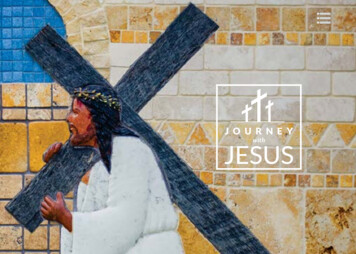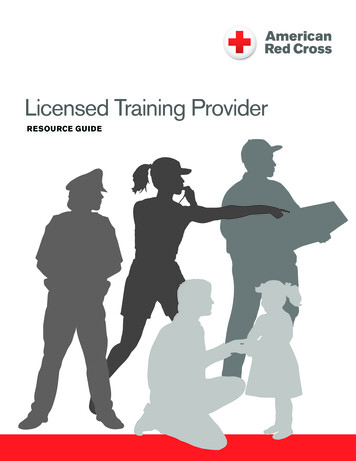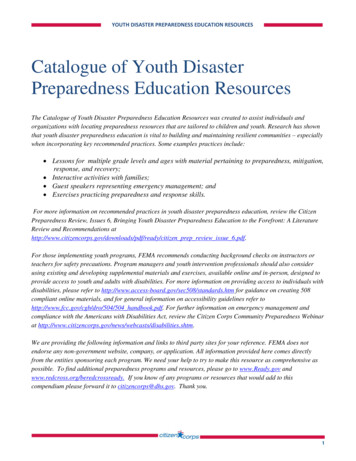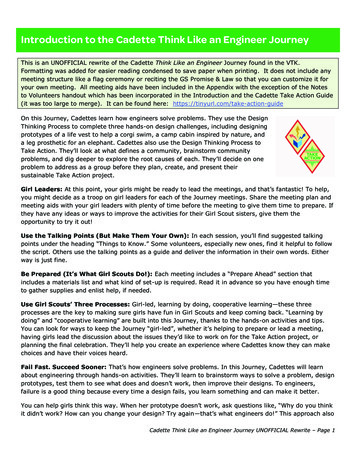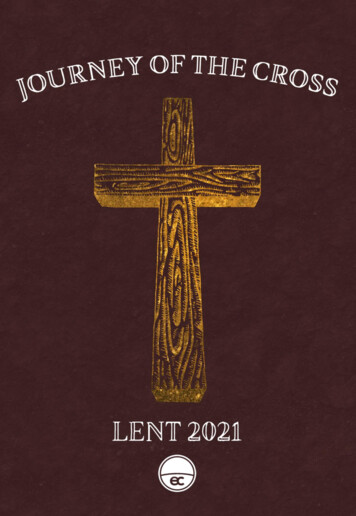
Transcription
Journey of the CrossA Devotional for the Season of LentExchange ChurchRolesville, NC
Exchange Church 2021Journey of the Cross: A Devotional for the Season of Lent by Exchange Church(Rolesville, NC). For more information or other resources, please visitwww.exchangenc.org.By the Church, for the Church.Prayers of Confession taken from The Worship Sourcebook (WSB). Reprinted bypermission from The Worship Sourcebook, 2004, Faith Alive ChristianResources.Collects taken from The Book of Common Prayer (BCP). New York, ChurchPublishing Incorporated 1979.Translation is taken from the ESV Bible (The Holy Bible, English StandardVersion ), copyright 2001 by Crossway, a publishing ministry of Good NewsPublishers. Used by permission. All rights reserved.
Then Jesus told his disciples,“If anyone would come after me,let him deny himself andtake up his cross and follow me.”Matthew 16:24
Table of ContentsIntroduction to LentHow to use this GuideFasting and FeastingAsh WednesdayFebruary 17The First SundayFebruary 21The Second SundayFebruary 28The Third SundayMarch 7The Fourth SundayMarch 14The Fifth SundayMarch 21Palm SundayMarch 28Maundy ThursdayApril 1Good FridayApril 2Holy SaturdayApril 3Easter SundayApril 4Appendix 1: Finding Our Place in His StoryAppendix 2: Praying the Lord’s Prayer כוננהו 1391220324456688088919498103104
The Journey of the CrossAt the heart of the Christian faith is the cross of Christ. It is at the cross thatJesus faithfully demonstrated his love for the Father and his love for his people,bearing the full weight of our sins and reconciling us with God through hisrighteousness. Yet, the life of Jesus was not merely a journey to the cross, forthat was not the end—it was a journey of the cross, whose end was theresurrection, in which he was raised again to new life, bringing forth thebeginning of a new creation.By God’s gracious design, the full story of the Gospel—the life, death, andresurrection of Jesus—is the story that is offered to each and every one of us.In fact, Jesus tells his disciples, “If anyone would come after me, let him denyhimself and take up his cross and follow me” (Matt. 16:24). We are thus calledinto this journey of the cross, whose end is the resurrected life, the abundantlife, in Christ Jesus. It is in light of this journey of the cross, that we prepare ourhearts during the season of Lent to celebrate the glory of the resurrection atEaster.What is the Season of Lent?The “Church Calendar” was set up by the early church fathers who orderedtime according to the story of Jesus Christ, which begins with Advent during theseason of Christmas to remember the incarnation, and culminates with Easterto remember the crucifixion and resurrection. Lent is the season leading up toEaster, in which the Church prepares for the celebration of Jesus’ atoningsacrifice for the sins of the world and his victory over death in his resurrection.The season of Lent has been traditionally marked by the forty days leading upto Easter, beginning with the first day, which is “Ash Wednesday.” The word“Lent” literally means “to lengthen” (from Old English) and was used to refer tothe period of Spring, in which the days were “lengthened.” The significance ofthe number forty is associated with the period of temptation Jesus experiencesin the wilderness as he fasted forty days and forty nights (Matthew 4; Luke 4),which not only served as the affirmation of his identity and role as the Son ofGod, but also the preparation for his ministry as the Messiah.The Church has traditionally observed Lent by participating in some type offasting (whether that be food and drink, or a form of comfort or entertainment)during the forty days (with the exception of Sundays). Fasting takes place1
throughout the week (Monday through Saturday), while certain types of feastingtakes place on each Sunday.Why Observe the Season of Lent?For centuries, the church has intentionally and collectively engaged the seasonof Lent which culminated with the celebration of Easter. Together they prayed,studied, fasted, and feasted, all with the aim to prepare their hearts to once againcelebrate the resurrection of Jesus Christ. Easter stands each year to remind usthat we are part of a story that is greater than any one of us. A story thatprovides a hope and a future. A story that binds a people together under thebanner of the Suffering Servant who became the Victorious Resurrected King ofall.Although Easter is the day on which we celebrate the resurrection of JesusChrist, it is not meant to be a celebration that is to come upon us suddenly,without notice, without preparation, without reflection. It is the culmination ofa season, around which we are to alter, orient, and tune our lives. The aim ofthe season of Lent is to renew our focus and refresh our love for the Savior, byputting off the tangible comforts of the world in order to reflect upon theglorious nature of the cross. By embracing this journey of the cross—aligningthe rhythms of our life with the life, death, and resurrection of Jesus Christ—we may put into practice the alignment of our story with his.Therefore, Easter is more than a day. It is a season that is set aside and orderedaccording to the story of redemption, into which we are invited to enter throughthe cruciform life that bears witness we belong to a Kingdom not of this world.Just as Jesus “sets his face to Jerusalem” (Luke 9:51) to suffer and die for theworld, we are to follow him in this journey by denying ourselves, taking up ourown cross, and following after Him (Luke 9:23). And being so united with in hisdeath, we are so united with him in his resurrection (Romans 6:5). As we thusembrace this season of fasting and repentance in light of the cross, we alsoprepare our hearts for feasting and celebration in light of His resurrection andthe resurrection to come.2
How to Use this GuideThis guide is designed in the long tradition of the church observing the seasonof Lent to walk as a Church through the season of Lent by daily meeting withthe Lord in Prayer, in Scripture, and in Reflection. Each day of the guide providesa form of worship with Daily Practices to shape the disposition of our heart, toset rhythms of worship for our soul, and to reflect upon the cross andresurrection of our Lord Jesus Christ. The aim is to approach the throne of Godtogether as his people––established by Grace, formed by his Word, andsanctified by his Spirit––for our good and for his glory.The guide will walk you through the weeks of Lent, beginning with AshWednesday, followed by the six Sundays, and culminating with the final days ofEaster: Maundy Thursday, Good Friday, Holy Saturday, and Easter Sunday. Sincewe will be reflecting upon the journey of the cross, we will have daily readingsfrom the Gospel of Matthew of which we will complete the entire book by theend of Lent. Every Sunday will focus on one of the “stages” of Jesus’ ministry,and there will be provided a liturgy (or order of worship) for your communityof friends and family to feast together.It is our prayer that that we together as a unified body: our hearts engaging thesame rhythms and readings, praying the same prayers, reflecting on the samequestions––all with the aim of being conformed more and more each day intothe image of the Lord Jesus Christ. In light of this prayer, this guide will be mosteffective if it is done in community, with another person, or with a Small Group.Let Scripture and Prayer guide your thoughts, form your affections, andstrengthen your peace. Use this guide daily as you are able, in whole or in part,by His grace and for His glory.The following will explain each element of the guide more thoroughly.3
The Daily PracticesThe following framework describes each of the practices that is to help fosteryour daily fellowship with the Lord. Although it is designed to guide you throughan intentional journey of prayer, it may serve as a template, to be used as closelyor as loosely as you find helpful.o Silence and StillnessEach morning will begin by practicing Silence and Stillness. This is a chance tostop, slow down, and be with Jesus. This will help us declutter and be fullypresent. It will encourage us to be before we do.o Invitation to Meet with GodA passage from Scripture will invites us to meet with God. We mustremember that our worship, our prayer, our devotion is always in his initialgrace and invitation.o Time of ConfessionAs we reflect on Christ’s work on the cross to pay for our sin, we take timeto search our hearts, confess the sin we continue to struggle with day by day,and thank God for his gracious faithful promise to forgive us and cleanse us.Each day will provide a guided confession to use as you find it helpful.o Scripture Reading and ReflectionEvery day we will be invited to read, to pray, and to live God’s Word. Wewill read through the Gospel of Matthew in its entirety over the course ofLent, with readings from the Isaiah on Sunday.o Praying the Lord’s PrayerWhen asked how to pray, Jesus provided his disciples what is known as the“Lord’s Prayer” (Matt. 6:9–13). This prayer can serve as a comprehensiveframework to guide our prayers on what is most essential. Each day of theweek we will pray through one line of the Lord’s Prayer, focusing on thatparticular emphasis of the prayer. In this way, we will pray the entire Lord’sPrayer throughout each week one day at a time. (For an overview and furtherexplanation, see Appendix 3, pp. 87–88.)o Commission to Serve the Lord and his KingdomEach day ends with God’s blessing and commission from his Word to live outthe true story of the Gospel by extending God’s love to his world.4
The Design of this GuideThe form and content of this devotional is purposefully designed to orient oursouls, hearts, and minds to the immutable truth that Jesus Christ died on thecross for our sins and on the third day rose again from the dead. Therefore,every element is meant to serve as a movement within a symphony that tunesour heart to sing the song of Christ Jesus’ victory on the cross.By reading through the entire Gospel of Matthew we are immersing ourselvesin the story of Jesus Christ. As we read this Gospel, we will be compelled tofollow him on the journey of the cross that culminates in his resurrection. Tofollow Jesus is to become his disciple and to become his disciples is to becomemore like him. In order to contemplate more deeply on this journey, we willoffer reflections on the Stages of Jesus’ Ministry and the essential characteristicsof the flourishing life in Jesus, which are called the Beatitudes.The Stages of Jesus’ Ministry in the Gospel of MatthewThe goal and ultimate aspiration of the Christian life is to become more likeJesus. But how does one become like Jesus if they do not know personally theintimate details of his life, words, and actions? How can we be conformed to theimage of Christ if we cannot observe his image with our eyes?We come to know who Christ is, what he was like, and what he teaches byreading the four books that document his life in the greatest detail. The firstGospel in the New Testament is the Gospel written by Matthew and it offers afirsthand glimpse into the life and ministry of Jesus. One of Jesus’ original 12disciples, Matthew had the great blessing of knowing Jesus on a deeply intimatelevel. Every miracle, every confrontation with the teachers and scribes, everycrowd captivated by his teachings, Matthew was there to witness them all.The follower of Jesus today may not have the luxury of seeing him in the humanbody he chose to enter the world with, but that does not mean we lack anexample to follow and model our lives after. The Gospel of Matthew offers aunique portrait of our Lord and Savior; his compassion, his zeal, his kindness, hisuncompromising dedication to the will of the Father. By observing and reflecting5
on Jesus as he appears in this book through the season of lent, we align ourselvesin the endeavor and goal of becoming more like him.On Sundays we will pause to settle our hearts and focus on seven different facetsof Jesus’ life. These seven events and categories are not exhaustive, but they dooffer an intimate look into the heart and mind of Christ. These topics include:The Baptism of JesusThe Temptation of JesusThe Miracles of JesusThe Teachings of JesusThe Suffering of JesusThe Crucifixion of JesusThe Resurrection of JesusAs you read about Jesus in the Gospel of Matthew, you will have manyopportunities to encounter the person who made it possible for you toexperience a restored relationship with God.There will likely be times when the Spirit identifies an area of life where you arenot being conformed to the image of Christ. Take note of these moments andthank God that He has seen fit to show us where we are lacking. Celebratethese moments of revelation by sharing with the people of God what he hasshown to you. It is in our neediness that the church can respond with grace andfulfill its duty to build up one another for the purpose of glorifying God as hisrepresentatives on the earth.The BeatitudesA key feature of the Gospel of Matthew is the Sermon on the Mount (chapters5–7), which is a collection of Jesus’ most famous teachings, including theBeatitudes (5:3–12) and the Lord’s Prayer (6:9–13). In these chapters, Jesus ispresented as a new Moses, who ascends the mountain and teaches his followershow they ought to live in light of the Kingdom of God. The Sermon on theMount is Jesus’ discourse on what it means to flourish as a human being made6
in the image of God. Or, in other words, Jesus is teaching what it means to behis disciple.Foundational to this discourse are the Beatitudes. The Beatitudes are eightproclamations of what the blessed life looks like according to Jesus: Blessed are the Poor in Spirit, for theirs is the Kingdom of Heaven Blessed are those who Mourn, for they shall be Comforted Blessed are the Meek, for they shall inherit the Earth Blessed are those who Hunger and Thirst for Righteousness, for they shallbe satisfied Blessed are the Merciful, for they shall receive Mercy Blessed are the Pure in Heart, for they shall see God Blessed are the Peacemakers, for they shall be called Sons of God Blessed are those who are Persecuted for righteousness’ sake, for theirsis the Kingdom of HeavenThe word “Beatitudes” is the Latin word for “blessed,” “happy,” or “flourishing.”This Latin word and the Greek word for blessed (makarios) are essentialconcepts in a larger philosophical conversation that took place in the ancientworld. The philosophical question then (which is still most relevant and pervasivetoday) was: “What is the good life?” This question can be phrased severaldifferent ways, such as “What is happiness?” and “What does it look like toflourish in life?” But an essential part of the answer to this question was todetermine how one ought to live (the vital practices, habits, and dispositions) inorder to be considered “blessed” or “happy” (makarios).If one were to ask, “What does it mean to live the good life?” or “What does itmean to be happy?” for the broader western society today, it would be generallydefined in hedonistic terms of material prosperity and comfort that precludessignificant hindrances for achievement. Happiness has been reduced to a mereplatitude, expressed as a simple hashtag to mark a positive event, however trivialit may be.Yet, look at what it means to be blessed according to Jesus. It is to be one whois Poor in Spirit, to be one who Mourns, to be one who is Meek, and even to be7
one who is Persecuted. This moral vision of the good life went against the grainof the good life according to the imperial expectations of ancient Rome, and itdirectly counters an overly secularized ideal of the good life today. For Jesus, tobe blessed, to be happy, to flourish in life as his disciple is to be marked by theparticular ways of being that are not of this world, which he himself embodiedperfectly and to which he has called all those who claim to be his. As we see inthe Gospel of Matthew, the blessed life of Christ is the journey of the cross––alife of denial of self and desperation for God.The Sermon on the Mount, and the Beatitudes in particular, reveal who we are,who we ought to become, and how we get there. With these beatitudes, Jesusis “offering and inviting his hearers into the way of being in the world that willresult in their true and full flourishing now and in the age to come.”1And if wetruly desire to follow Jesus, to be his disciple and live a blessed life, we mustbecome not only hearers of his Word but also doers of his Word (Matt. 7:24).Such a calling is nothing less than the call to be “perfect, as your heavenly Fatheris perfect” (5:48). However, to live such a life of blessing we cannot do it on ourown strength with our own resources––it is only by the grace of God. Toflourish in this calling, we desperately need: Jesus Christ, the one who is happiness, goodness, and blessing, who hasgone before us in perfect faithfulness as the Son of God The Church, the community of saints, fellow pilgrims who are also on thisJourney of the Cross The Holy Spirit, the one who empowers the blessed life in Christ, throughthe presence, peace, and power of God21J. Pennington, The Sermon on the Mount and Human Flourishing: A Theological Commentary (GrandRapids: Baker Academic, 2017), 144.2S. McKnight, Sermon on the Mount. The Story of God Bible Commentary (Grand Rapids: Zondervan,2013), 13–14.8
Fasting and FeastingInasmuch as the story of the Gospel is formed by both the cross and theresurrection, the Season of Lent is marked by the rhythm of fasting and feasting.Fasting brings to focus the significance of the cross, while feasting anticipates thecelebration of the resurrection.FastingThe season of Lent provides an opportunity to practice self-denial throughfasting and repentance, enabling our hearts, souls, and minds to reflect upon andbe formed by the weight of the cross.Throughout the days of the week (Monday through Saturday), you areencouraged to engage in some type fasting, which is voluntarily going withoutfood, or some other good or comfort regularly enjoyed. There are differenttypes of fasting that one may partake during this time. The most common is afast from food and drink, whether that is fasting from certain types of food ordrink (such as dessert, caffeinated drinks, etc.), or fasting from all food onparticular days (though, one should not fast from water). Other types couldinclude fasting from entertainment such as TV, movies, music, the internet, orsocial media. The purpose of these fasts is to set aside the things that mayultimately distract us from self-reflection and communing with God.It is important to note that fasting is not to be understood as a means by whichwe are able to get something from God or to earn his favor. Nor are we to fastin order for us to be praised by others: as Jesus warns his followers not topartake in fasting and prayer in order to be seen by others (Matthew 6:16), weshould be all the more careful not to bring attention to our disciplines, especiallywith posting on social media. Let your disposition and discipline be that yourfasting “may not be seen by others but by your Father who is in secret. Andyour Father who sees in secret will reward you” (Matthew 6:18).Fasting and prayer are to provide reflection upon the state of our souls in orderthat we may express our dependence upon God’s provision, our desperationfor God’s grace, and our devotion to God’s glory. In this way, fasting is not tobe a burden of guilt but an opportunity for grace. In fact, we should understandour call to fast in light of our call to feast, in which our fasting from the things ofthis world anticipates our feasting with the King in his glory (Revelation 19:6–9).9
FeastingThe season of Lent also provides an opportunity to practice celebration throughfeasting and fellowship, enabling our hearts, souls, and minds to anticipate andbe formed by the glory of the resurrection.Every Sunday, you are encouraged to engage in feasting. The feast can be theenjoyment of the thing from which you have decided to fast (such as dessertsor caffeine), or it can simply be the enjoyment of a meal that intentionally focuseson God’s grace, goodness, and glory. Since the Christian life is never meant tobe lived in isolation the purpose of this guide is to be done together as the Bodyof Christ. Therefore, the feasts that we choose to observe should be intentionalin gathering with our friends, family, and neighbors. The purpose of these feastsis to incline our hearts and our hopes to the glory of the resurrection to come.Please take some time to pray and reflect upon the areas of your life wherefasting might help you rely on the grace of God in order that you may betterreflect on the glory of God. Also consider how you may spend your times offeasting with your family, friends, and neighbors to edify one another.By His Grace for His GloryAs a final word of encouragement, this guide is in no way to be used as a measurefor our righteousness nor should it become a burden for our guilt. Rather, it ismeant to assist each of us to fix our eyes on Jesus Christ and encourage oneanother in this race of endurance (Hebrews 12:1–2). In this light, we shouldapproach this guide with the grace that is found in Christ Jesus—for our goodand for his glory.10
O Lord, who hast mercy upon all,take away from me my sins,and mercifully kindle in methe fire of thy Holy Spirit.Take away from me the heart of stone,and give me a heart of flesh,a heart to love and adore Thee,a heart to delight in Thee,to follow and enjoy Thee,for Christ's sake, Amen.St. Ambrose of Milan (AD 339–397)11
Ash WednesdayAlmighty and everlasting God, youhate nothing you have made andforgive the sins of all who arepenitent: Create and make in usnew and contrite hearts, that we,worthily lamenting our sins andacknowledging our wretchedness,may obtain of you, the God of allmercy, perfect remission andforgiveness; through Jesus Christour Lord, who lives and reigns withyou and the Holy Spirit, one God,for ever and ever. Amen.Book of Common Prayer12
Ash WednesdayEvery year the Season of Lent begins with Ash Wednesday. In Scripture, ash ordust symbolizes death and frailty (Gen. 18:27), judgment (Deut. 28:24), mourning(Job 2:12), and repentance (Jon. 3:6). In this light, Ash Wednesday is meant forus to meditate on our own sin and death; that we come to terms that we aredust and to dust we shall return (Gen. 3:19).As the Season of Lent is to prepare our hearts to celebrate the Resurrection ofJesus Christ on Easter, and an important part of our preparation is to rememberwhy Jesus Christ had to die in the first place. In the beginning, the first man andthe first woman disobeyed God in the garden, desiring to live on their ownterms instead of entrusting themselves to God’s good will (Gen. 3). Thisrejection of God, who is our life and the length of our days, meant for them andfor all humanity, death. In God’s punishment for humanity’s sin, He declares, “foryou are dust, and to dust you shall return” (Gen. 3:19). Like Adam and Eve, wehave all “gone astray; we have turned––every one––to his own way,” and forthis rebellion, “the LORD has laid on him the iniquity of us all” (Is. 53:6).Ash Wednesday is thus meant to be a solemn reflection upon the profoundtruths of the Gospel, in which we are to:1. Reflect upon our mortality, sinfulness, and need for the Savior2. Repent of our sin and renew our commitment to follow Christ3. Remember with confidence and gratitude that Christ has conquereddeath and sin3Therefore, let us reflect upon our sin and our own mortality, in order that it maylead us to repentance, to recognize that we desperately need a Savior, and torejoice that Christ has conquered death and sin. Even as we mourn our sin onAsh Wednesday, we can take heart that Easter Sunday is coming.3Worship Source Book, 541.13
Ash Wednesday February 17“Consider yourself dead to sin and alive in Jesus Christ”Use this guide of prayer, in whole or in part, as the Lord leads you.Silence and StillnessTake two whole minutes of complete silence and stillness to prepare your heart, soul,and mind to meet with the Lord. Adjust to a posture of surrender and allow yourself tobe attentive to his love. Linger there.Invitation to Meet with God: Psalm 40:17Time of Confession: Use this prayer guide your time in confessionWe dream, make plans, and talk about what we’ll do in the near future. We don’t alwaysthink about what you want. Instead, we make choices that we think are good for us. Butwe are only here because you take care of us. We confess that we forget we need you allthe time. We confess that sometimes we make choices that aren’t what you want. Wedon’t know what is best for our lives. Holy God, we are sorry for our sin. Help us toremember we live because of you. Help us to do what you want us to do through Jesus,our Lord. Amen. (WSB, 546)Scripture Reading and Reflection: Genesis 3; Psalm 901. Behold God: What does today’s reading tell us about God?2. Live for God: How should we respond to God’s word today?Prayer of AdorationJesus, we acknowledge that there is a REASON we had to be redeemed. All that touchesour hands falls apart eventually. Left to ourselves, we like the laws of entropy that governour world, will fall into more disarray, not less. We confess we cannot save ourselvesfrom the mess that we have made. We cannot make it all better. But thank you that wedo not have to, for in your mercy you entered the muck and mire of our own making andyou took it on yourself and then gave us your goodness and righteousness and holinessinstead. In Jesus’ name, Amen.Commission to Serve the Lord and his Kingdom: Romans 16:25–27Now to him who is able to strengthen you according to my gospel and the preaching ofJesus Christ, according to the revelation of the mystery that was kept secret for long agesbut has now been disclosed and through the prophetic writings has been made known toall nations, according to the command of the eternal God, to bring about the obedienceof faith—to the only wise God be glory forevermore through Jesus Christ! Amen.14
Thursday February 18“Consider yourself dead to sin and alive in Jesus Christ”Use this guide of prayer, in whole or in part, as the Lord leads you.Silence and StillnessTake two whole minutes of complete silence and stillness to prepare your heart, soul,and mind to meet with the Lord. Adjust to a posture of surrender and allow yourself tobe attentive to his love. Linger there.Invitation to Meet with God: Psalm 86:1–4Incline your ear, O LORD, and answer me, for I am poor and needy. Preserve my life, forI am godly; save your servant, who trusts in you—you are my God. Be gracious to me, OLord, for to you do I cry all the day. Gladden the soul of your servant, for to you, O Lord,do I lift up my soul.Time of Confession: Use this prayer guide your time in confessionLord God, it is hard to think that we will die someday. We dream, make plans, and talkabout what we’ll do in the near future. We don’t always think about what you want.Instead, we make choices that we think are good for us. But we are only here becauseyou take care of us. We confess that we forget we need you all the time. We confess thatsometimes we make choices that aren’t what you want. We don’t know what is best forour lives. Holy God, we are sorry for our sin. Help us to remember we live because ofyou. Help us to do what you want us to do through Jesus, our Lord. Amen. (WSB, 90)Scripture Reading and Reflection: Matthew 1:1–251. Behold Jesus: What does today’s reading tell us about Jesus?2. Live for Jesus: How should we respond to God’s word today?Prayer of AdorationWe acknowledge that the great exchange of our sin for your righteousness is the mostcritical we can ever make, and we make it gladly. Jesus in our place, Lord. Thank you thatit’s enough. That as we confess our sins you are faithful and just to forgive us and cleanseus from all unrighteousness (I John 1:9). That there is now no condemnation for thosewho have hidden themselves in your goodness (Romans 8:1). The work that you did onthe cross has covered the sin and shame and given us a new life here and now and thehope of heaven in your presence for all eternity. In Jesus’ name, Amen.Commission to Serve the Lord: 1 Corinthians 16:13–14Be watchful, stand firm in the faith, act like men, be strong. Let all that you do be donein love.15
The Beatitudes Poor in SpiritJesus begins his beatitudes with, “Blessed are the poor in spirit, for theirs is the Kingdom of Heaven”(Matt. 5:3). According to the standards of the world, to live a good life, to be truly happy, it is necessaryto have wealth and independence. These characteristics are essential to what would constitute successtoday. However, Jesus counters this ideal of happiness with two aspects of one characterized as “poorin spirit.”First, Jesus is saying that to be poor, to be oppressed, and to be destitute does not exclude one fromthe good life, but rather it is characteristically an advantage for those who desire to be part of theKingdom of Heaven (cf. Luke 6:20, 24). According to Hannah’s prayer, “The LORD makes poor andmakes rich, he brings low and he exalts. He raises up the poor from the dust; he lifts the needy fromthe ash heap to make them sit with princes” (1 Sam. 2:7–8). This reversal of fortunes is echoed in theMagnificat of Mary, where she prays, “[God] has filled the hungry with good things, and the rich hehas sent away empty” (Luke 1:53). In other words, God deeply cares for the poor, the outcast, therefugee. And if one finds himself or herself in such a state, Scripture promises that God sees and Godknows (cf. Ex. 2:25) and will make things right.Second, Jesus is saying that to be poor of spirit is to rely fully on God for grace for the undeserving,
The Journey of the Cross At the heart of the Christian faith is the cross of Christ. It is at the cross that Jesus faithfully demonstrated his love for the Father and his love for his people, bearing the full weight of our sins and reconciling us with God through his righteousness. Yet, the life of Jesus was not merely a journey to the cross, for



